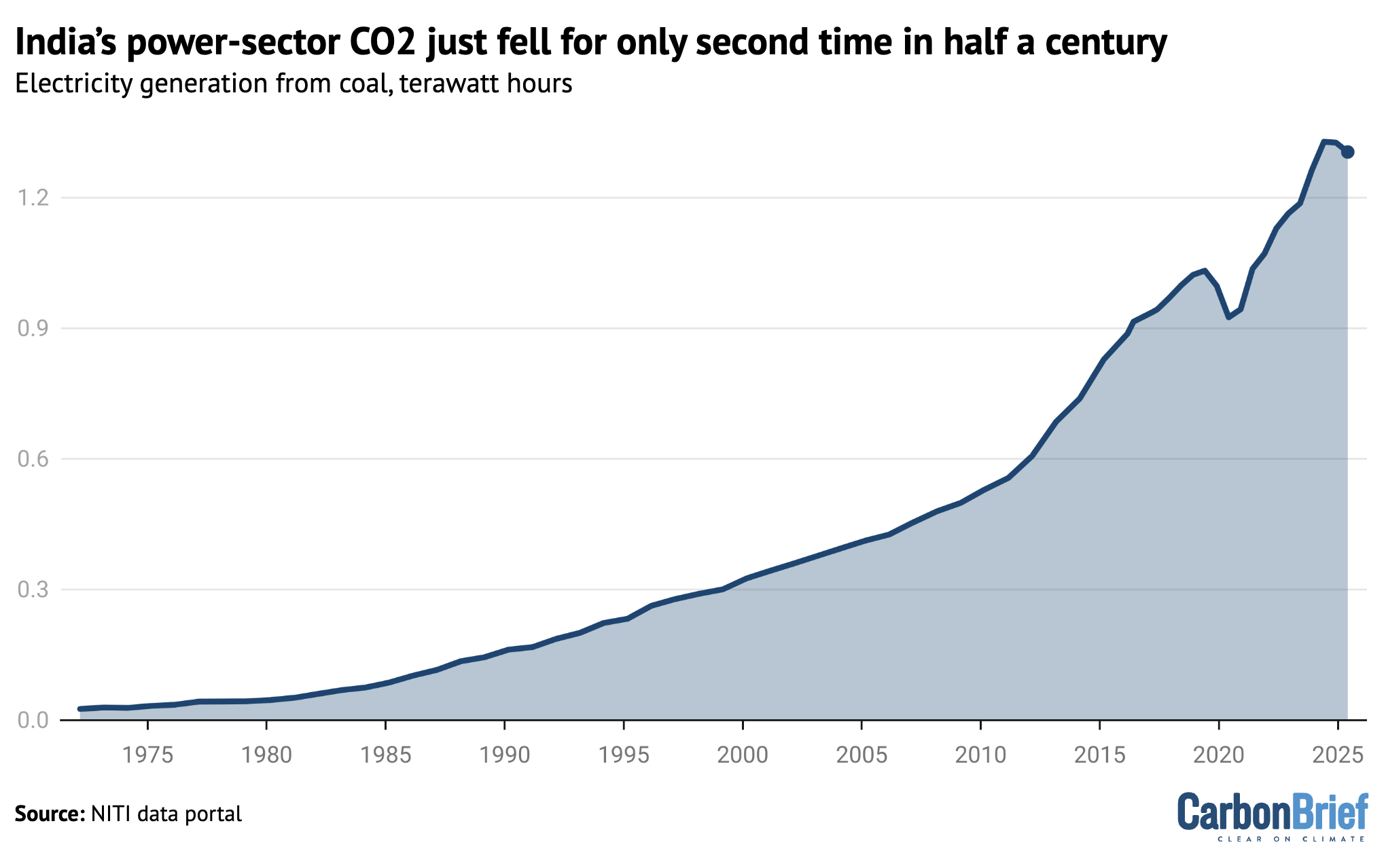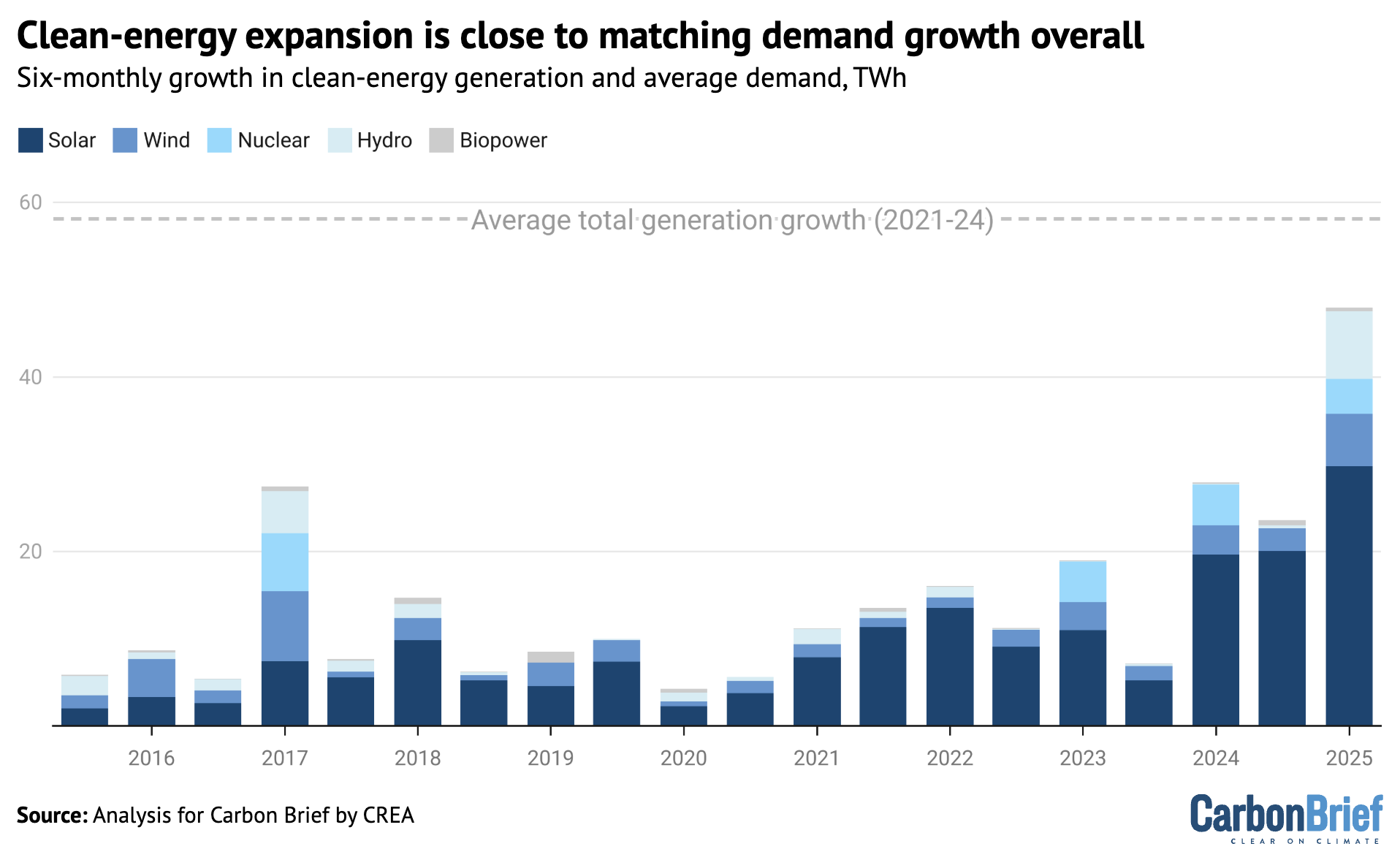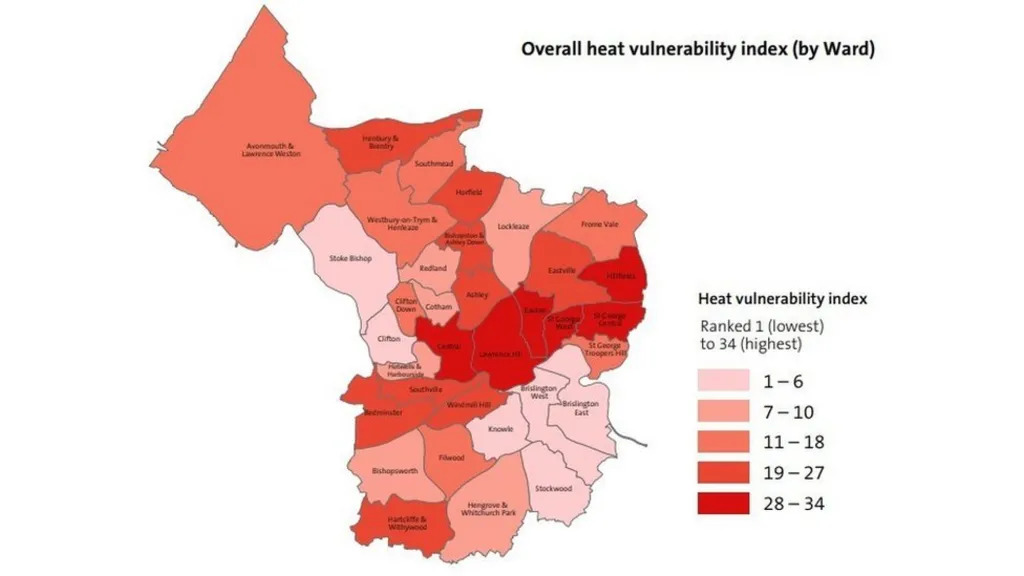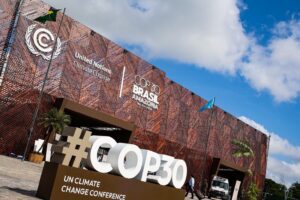India’s carbon dioxide (CO2) emissions from its power sector fell by 1% year-on-year in the first half of 2025 and by 0.2% over the past 12 months, only the second drop in almost half a century.
As a result, India’s CO2 emissions from fossil fuels and cement grew at their slowest rate in the first half of the year since 2001 – excluding Covid – according to new analysis for Carbon Brief.
The analysis is the first of a regular new series covering India’s CO2 emissions, based on monthly data for fuel use, industrial production and power output, compiled from numerous official sources.
(See the regular series on China’s CO2 emissions, which began in 2019.)
Other key findings on India for the first six months of 2025 include:
- The growth in clean-energy capacity reached a record 25.1 gigawatts (GW), up 69% year-on-year from what had, itself, been a record figure.
- This new clean-energy capacity is expected to generate nearly 50 terawatt hours (TWh) of electricity per year, nearly sufficient to meet the average increase in demand overall.
- Slower economic expansion meant there was zero growth in demand for oil products, a marked fall from annual rates of 6% in 2023 and 4% in 2024.
- Government infrastructure spending helped accelerate CO2 emissions growth from steel and cement production, by 7% and 10%, respectively.
The analysis also shows that emissions from India’s power sector could peak before 2030, if clean-energy capacity and electricity demand grow as expected.
The future of CO2 emissions in India is a key indicator for the world, with the country – the world’s most populous – having contributed nearly two-fifths of the rise in global energy-sector emissions growth since 2019.
India’s surging emissions slow down
In 2024, India was responsible for 8% of global energy-sector CO2 emissions, despite being home to 18% of the world’s population, as its per-capita output is far below the world average.
However, emissions have been growing rapidly, as shown in the figure below.
The country contributed 31% of global energy-sector emissions growth in the decade to 2024, rising to 37% in the past five years, due to a surge in the three-year period from 2021-23.
More than half of India’s CO2 output comes from coal used for electricity and heat generation, making this sector the most important by far for the country’s emissions.
The second-largest sector is fossil fuel use in industry, which accounts for another quarter of the total, while oil use for transport makes up a further eighth of India’s emissions.
India’s CO2 emissions from fossil fuels and cement grew by 8% per year from 2019 to 2023, quickly rebounding from a 7% drop in 2020 due to Covid.
Before the Covid pandemic, emissions growth had averaged 4% per year from 2010 to 2019, but emissions in 2023 and 2024 rose above the pre-pandemic trendline.
This was despite a slower average GDP growth rate from 2019 to 2024 than in the preceding decade, indicating that the economy became more energy- and carbon-intensive. (For example, growth in steel and cement outpaced the overall rate of economic growth.)
A turnaround came in the second half of 2024, when emissions only increased by 2% year-on-year, slowing down to 1% in the first half of 2025, as seen in the figure below.

The largest contributor to the slowdown was the power sector, which was responsible for 60% of the drop in emissions growth rates, when comparing the first half of 2025 with the years 2021-23.
Oil demand growth slowed sharply as well, contributing 20% of the slowdown. The only sectors to keep growing their emissions in the first half of 2025 were steel and cement production.
Another 20% of the slowdown was due to a reduction in coal and gas use outside the power, steel and cement sectors. This comprises construction, industries such as paper, fertilisers, chemicals, brick kilns and textiles, as well as residential and commercial cooking, heating and hot water.
This is all shown in the figure below, which compares year-on-year changes in emissions during the second half of 2024 and the first half of 2025, with the average for 2021-23.

Power sector emissions fell by 1% in the first half of 2025, after growing 10% per year during 2021-23 and adding more than 50m tonnes of CO2 (MtCO2) to India’s total every six months.
Oil product use saw zero growth in the first half of 2025, after rising 6% per year in 2021-23.
In contrast, emissions from coal burning for cement and steel production rose by 10% and 7%, respectively, while coal use outside of these sectors fell 2%.
Gas consumption fell 7% year-on-year, with reductions across the power and industrial sectors as well as other users. This was a sharp reversal of the 5% average annual growth in 2021-23.
Power-sector emissions pause
The most striking shift in India’s sectoral emissions trends has come in the power sector, where coal consumption and CO2 emissions fell 0.2% in the 12 months to June and 1% in the first half of 2025, marking just the second drop in half a century, as shown in the figure below.
The reduction in coal use comes after more than a decade of break-neck growth, starting in the early 2010s and only interrupted by Covid in 2020. It also comes even as the country plans large amounts of new coal-fired generating capacity.

In the first half of 2025, total power generation increased by 9 terawatt hours (TWh) year-on-year, but fossil power generation fell by 29TWh, as output from solar grew 17TWh, from wind 9TWh, from hydropower by 9TWh and from nuclear by 3TWh.
Analysis of government data shows that 65% of the fall in fossil-fuel generation can be attributed to lower electricity demand growth, 20% to faster growth in non-hydro clean power and the remaining 15% to higher output at existing hydropower plants.
Slower growth in electricity usage was largely due to relatively mild temperatures and high rainfall, in contrast to the heatwaves of 2024. A slowdown in industrial sectors in the second quarter of the year also contributed.
In addition, increased rainfall drove the jump in hydropower generation. India received 42% above-normal rainfall from March to May 2025. (In early 2024, India’s hydro output had fallen steeply as a result of “erratic rainfall”.)
Lower temperatures and this abundant rainfall reduced the need for air conditioning, which is responsible for around 10% of the country’s total power demand. In the same period in 2024, demand surged due to record heatwaves and higher temperatures across the country.
The growth in clean-power generation was buoyed by the addition of a record 25.1GW of non-fossil capacity in the first half of 2025. This was a 69% increase compared with the previous period in 2024, which had also set a record.
Solar continues to dominate new installations, with 14.3GW of capacity added in the first half of the year coming from large scale solar projects and 3.2GW from solar rooftops.
Solar is also adding the majority of new clean-power output. Taking into account the average capacity factor of each technology, solar power delivered 62% of the additional annual generation, hydropower 16%, wind 13% and nuclear power 8%.
The new clean-energy capacity added in the first half of 2025 will generate record amounts of clean power. As shown in the figure below, the 50TWh per year from this new clean capacity is approaching the average growth of total power generation.
(When clean-energy growth exceeds total demand growth, generation from fossil fuels declines.)

India is expected to add another 16-17GW of solar and wind in the second half of 2025. Beyond this year, strong continued clean-energy growth is expected, towards India’s target for 500GW of non-fossil fuel capacity by 2030 (see below).
Slowing oil demand growth
The first half of 2025 also saw a significant slowdown in India’s oil demand growth. After rising by 6% a year in the three years to 2023, it slowed to 4% in 2024 and zero in the first half of 2025.
The slowdown in oil consumption overall was predominantly due to slower growth in demand for diesel and “other oil products”, which includes bitumen.
In the first quarter of 2025, diesel demand actually fell, due to a decline in industrial activity, limited weather-related mobility and – reportedly – higher uptake of vehicles that run on compressed natural gas (CNG), as well as electricity (EVs).
Diesel demand growth increased in March to May, but again declined in June because of early and unusually severe monsoon rains in India, leading to a slowdown in industrial and mining activities, disrupted supply-chains and transport of raw material, goods and services.
The severe rains also slowed down road construction activity, which in turn curtailed demand for transportation, construction equipment and bitumen.
Weaker diesel demand growth in 2024 had reflected slower growth in economic activity, as growth rates in the industrial and agricultural sectors contracted compared to previous years.
Another important trend is that EVs are also cutting into diesel demand in the commercial vehicles segment, although this is not yet a significant factor in the overall picture.
EV adoption is particularly notable in major metropolitan cities and other rapidly emerging urban centres and in the logistics sector, where they are being preferred for short haul rides over diesel vans or light commercial vehicles.
EVs accounted for only 7.6% of total vehicle sales in the financial year 2024-25, up 22.5% year-on-year, but still far from the target of 30% by 2030.
However, any significant drop in diesel demand will be a function of adoption of EV for long-haul trucks, which account for 32% of the total CO2 emissions from the transport sector. Only 280 electric trucks were sold in 2024, reported NITI Aayog.
Trucks remain the largest diesel consumers. Moreover, truck sales grew 9.2% year-on-year in the second quarter of 2025, driven in part by India’s target of 75% farm mechanisation by 2047. This sales growth may outweigh the reduction in diesel demand due to EVs. Subsidies for electric tractors have seen some pilots, but demand is yet to take off.
Apart from diesel, petrol demand growth continued in the first half of 2025 at the same rate as in earlier years. Modest year-on-year growth of 1.3% in passenger vehicle sales could temper future increases in petrol demand, however. This is a sharp decline from 7.5% and 10% growth rates in sales in the same period in 2024 and 2023.
Furthermore, EVs are proving to be cheaper to run than petrol for two- and three-wheelers, which may reduce the sale of petrol vehicles in cities that show policy support for EV adoption.
Steel and cement emissions continue to grow
As already noted, steel and cement were the only major sectors of India’s economy to see an increase in emissions growth in the first half of 2025.
While they were only responsible for around 12% of India’s total CO2 emissions from fossil fuels and cement in 2024, they have been growing quickly, averaging 6% a year for the past five years.
The growth in emissions accelerated in the first half of 2025, as cement output rose 10% and steel output 7%, far in excess of the growth in economic output overall.
Steel and cement growth accelerated further in July. A key demand driver is government infrastructure spending, which tripled from 2019 to 2024.
In the second quarter of 2025, the government’s capital expenditure increased 52% year-on-year. albeit from a low base during last year’s elections. This signals strong growth in infrastructure.
The government is targeting domestic steel manufacturing capacity of 300m tonnes (Mt) per year by 2030, from 200Mt currently, under the National Steel Policy 2017, supported by financial incentives for firms that meet production targets for high quality steel.
The government also imposed tariffs on steel imports in April and stricter quality standards for imports in June, in order to boost domestic production.
Government policies such as Pradhan Mantri Awas Yojna – a “housing for all” initiative under which 30m houses are to be built by FY30 – is further expected to lift demand for steel and cement.
The automotive sector in India is expected to grow at a fast pace, with sales expected to reach 7.5m units for passenger vehicle and commercial vehicle segments from 5.1m units in 2023, in addition to rapid growth in electric vehicles. This can be expected to be another key driver for growth of the steel sector, as 900 kg of steel is used per vehicle.
Without stringent energy efficiency measures and the adoption of cleaner fuel, the expected growth in steel and cement production could drive significant emissions growth from the sector.
Power-sector emissions could peak before 2030
Looking beyond this year, the analysis shows that CO2 from India’s power sector could peak before 2030, having previously been the main driver of emissions growth.
To date, India’s clean-energy additions have been lagging behind the growth in total electricity demand, meaning fossil-fuel demand and emissions from the sector have continued to rise.
However, this dynamic looks likely to change. In 2021, India set a target of having 500GW of non-fossil power generation capacity in place by 2030. Progress was slow at first, so meeting the target implies a substantial acceleration in clean-energy additions.
The country has been laying the groundwork for such an acceleration.
There was 234GW of renewable capacity in the pipeline as of April 2025, according to the Ministry of New and Renewable Energy. This includes 169GW already awarded contracts, of which 145GW is under construction, and an additional 65GW put out to tender. There is also 5.2GW of new nuclear capacity under construction.
If all of this is commissioned by 2030, then total non-fossil capacity would increase to 482GW, from 243GW at the end of June 2025, leaving a gap of just 18GW to be filled with new projects.
When the non-fossil capacity target was set in 2021, CREA assessed that the target would suffice to peak demand for coal in power generation before 2030. This assessment remains valid and is reinforced by the latest Central Electricity Authority (CEA) projection for the country’s “optimal power mix” in 2030, shown in the figure below.

In the CEA’s projection, the share of non-fossil power generation rises to 44% in the 2029-30 fiscal year, up from 25% in 2024-25. From 2025 to 2030, power demand growth, averaging 6% per year, is entirely covered from clean sources.
To accomplish this, the growth in non-fossil power generation would need to accelerate over time, meaning that towards the end of the decade, the growth in clean power supply would clearly outstrip demand growth overall – and so power generation from fossil fuels would fall.
While coal-power generation is expected to flatline, large amounts of new coal-power capacity is still being planned, because of the expected growth in peak electricity demand.
The post-Covid increase in electricity demand has given rise to a wave of new coal power plant proposals. Recent plans from the government target an increase in coal-power capacity by another 80-100GW by 2030-32, with 35GW already under construction as of July 2025.
The rationale for this is the increase in peak electricity loads, associated in particular with worsening heatwaves and growing use of air conditioning. The increase might yet prove unneeded.
Analysis by CREA shows that solar and wind are making an increasing contribution to meeting peak loads. This contribution will increase with the roll-out of solar power with integrated battery storage, the cost of which fell by 50-60% from 2023 to 2025.
The latest auction held in India saw solar power with battery storage bidding at prices, per unit of electricity generation, that were lower than the cost of new coal power.
This creates the opportunity to accelerate the decarbonisation of India’s power sector, by reducing the need for thermal power capacity.
The clean-energy buildout has made it possible for India to peak its power-sector emissions within the next few years, if contracted projects are built, clean-energy growth is maintained or accelerated beyond 2030 and demand growth remains within the government’s projections.
This would be a major turning point, as the power sector has been responsible for half of India’s recent emissions growth. In order to peak its emissions overall, however, India would still need to take further action to address CO2 from industry and transport.
With the end-of-September 2025 deadline nearing, India has yet to publish its international climate pledge (nationally determined contribution, NDC) for 2035 under the Paris Agreement, meaning its future emissions path, in the decades up to its 2070 net-zero goal, remains particularly uncertain.
The country is expected to easily surpass the headline climate target from its previous NDC, of cutting the emissions intensity of its economy to 45% below 2005 levels by 2030. As such, this goal is “unlikely to drive real world emission reductions”, according to Climate Action Tracker.
In July of this year, it met a 2030 target for 50% of installed power generating capacity to be from non-fossil sources, five years early.
About the data
This analysis is based on official monthly data for fuel consumption, industrial production and power generation from different ministries and government institutes.
Coal consumption in thermal power plants is taken from the monthly reports downloaded from the National Power Portal of the Ministry of Power. The data is compiled for the period January 2019 until June 2025. Power generation and capacity by technology and fuel on a monthly basis are sourced from the NITI data portal.
Coal use at steel and cement plants, as well as process emissions from cement production, are estimated using production indices from the Index of Eight Core Industries released monthly by the Office of Economic Adviser, assuming that changes in emissions follow production volumes.
These production indices were used to scale coal use by the sectors in 2022. To form a basis for using the indices, monthly coal consumption data for 2022 was constructed for the sectors using the annual total coal consumption reported in IEA World Energy Balances and monthly production data in a paper by Robbie Andrew, on monthly CO2 emission accounting for India.
Annual cement process emissions up to 2024 were also taken from Robbie Andrew’s work and scaled using the production indices. This approach better approximated changes in energy use and emissions reported in the IEA World Energy Balances, than did the amounts of coal reported to have been dispatched to the sectors, showing that production volumes are the dominant driver of short-term changes in emissions.
For other sectors, including aluminium, auto, chemical and petrochemical, paper and plywood, pharmaceutical, graphite electrode, sugar, textile, mining, traders and others, coal consumption is estimated based on data on despatch of domestic and imported coal to end users from statistical reports and monthly reports by the Ministry of Coal, as consumption data is not available.
The difference between consumption and dispatch is stock changes, which are estimated by assuming that the changes in coal inventories at end user facilities mirror those at coal mines, with end user inventories excluding power, steel and cement assumed to be 70% of those at coal mines, based on comparisons between our data and the IEA World Energy Balances.
Stock changes at mines are estimated as the difference between production at and despatch from coal mines, as reported by the Ministry of Coal.
In the case of the second quarter of the year 2025, data on domestic coal has been taken from the monthly reports by the Ministry of Coal. The regular data releases on coal imports have not taken place for the second quarter of 2025, for unknown reasons, so data was taken from commercial data providers Coal Hub and mjunction services ltd.
Product-wise petroleum product consumption data, as well as gas use by sector, was downloaded from the Petroleum Planning and Analysis Cell of the Ministry of Petroleum & Natural Gas.
As the fuel dispatch and consumption data is reported as physical volumes, calorific values are taken from IEA’s World Energy Balance and CO2 emission factors from 2006 IPCC Guidelines for National Greenhouse Gas Inventories.
Calorific values are assigned separately to different fuel types, including domestic and imported coal, anthracite and coke, as well as petrol, diesel and several other oil products.
The post Analysis: India’s power-sector CO2 falls for only second time in half a century appeared first on Carbon Brief.
Analysis: India’s power-sector CO2 falls for only second time in half a century
Climate Change
Guest post: Why cities need more than just air conditioning for extreme heat
Cities around the world are facing more frequent and intense bouts of extreme heat, leading to an increasing focus on the use of air conditioning to keep urban areas cool.
With the UK having experienced its hottest summer on record in 2025, for example, there was a wave of media attention on air conditioning use.
Yet less than 5% of UK homes have air conditioning and those most vulnerable – older adults, low-income households or people with pre-existing health conditions – often cannot afford to install or operate it.
While air conditioning may be appropriate in certain contexts, such as hospitals, community spaces or care homes, it is not the only solution.
Our research as part of the IMAGINE Adaptation project shows that a universal focus on technical solutions risks deepening inequality and has the potential to overlook social, economic and environmental realities.
Instead, to adapt to record temperatures, our research suggests a keener focus on community and equity is needed.
Contextualising urban heat vulnerability
In the UK, heatwaves are becoming more frequent and severe. Moreover, the evidence points to significant disparities in exposure and vulnerability. By 2080, average summer temperatures could rise by up to 6.7C, according to the Met Office.
During the summer of 2023, around 2,295 heat-related deaths occurred across the UK, with 240 in the South West region. Older adults, particularly those over 65, were the most affected, government figures show.
A recent UN Environment Programme report highlights that there is an “urgent” need for adaptation strategies to deal with rising summer heat.
However, our research shows that framing air conditioning as the default solution risks worsening urban heat by increasing emissions and energy bills, as well as missing the opportunity to design more inclusive, human-centred responses to rising temperatures.
Addressing both gradual and extreme heat involves understanding who is most affected, how people move through cities and the role of social networks.
In recognition of this, cities around the world are already developing potential cooling strategies that combine low-emission interventions with community-based care.
Expanding the concept of ‘cool spaces’
In the UK, Bristol City Council is working on a “cool space” initiative with support from the European Research Council-funded project IMAGINE Adaptation.
The initiative aims to identify a network of public spaces that can offer respite during periods of extreme heat. These spaces can potentially include parks, libraries, community centres or even urban farms.
The map below shows how heat vulnerability varies across the city of Bristol, identifying neighbourhoods most at risk from current and future heatwaves.

But what makes a space “cool”? We used surveys, interviews and workshops to collectively come to an understanding of what a cool space means for Bristol communities.
What emerged from our work is that “cool” is about far more than temperature.
Shade, natural ventilation, seating, access to water and toilets all contribute to comfort, but they do not capture the full picture.
Social and cultural factors, such as whether people feel welcome, whether spaces are free to use or whether children can safely reach them, are equally important. For example, we found that while many community spaces are open to the public, people are often unsure whether they can spend time there without having to buy something.
Our research shows that the presence of a café, even unintentionally, can signal that time and space come at a cost. Clear signage, free entry, drinking water and toilets can help people feel that they are welcome to stay.
Additionally, our research highlights that it is important to recognise that public space is not experienced equally by everyone. Some city centre parks, for instance, may be seen as unwelcoming by people who do not drink alcohol or who feel uncomfortable around noise and large groups.
Creating cool spaces that serve the whole community involves understanding these dynamics and exploring more inclusive alternatives.
Connecting adaptation efforts
The importance of understanding the dynamics of adaptation efforts is especially relevant when considering children, as they are often more vulnerable to increasing temperatures.
At Felix Road adventure playground – one of the early pilot sites in Bristol – staff introduced shaded areas, drinking water and ice lollies to support children during hot weather.
However, adaptation does not just happen at individual sites, but between them, as connectivity to the playground by foot or public transport exposes children to the heat and traffic.
This highlights that adaptation to heat is a city-wide concern, as the effectiveness of individual cooling interventions can depend on both the space itself and how it can be accessed and used by vulnerable populations.
Buses and trains can become uncomfortably hot, making travel difficult for those most at risk. Our research suggests that for some, staying home might seem safer, but many lack cooling options.
Early discussions in the cool space trial show this is especially true for older adults, who also seek social contact alongside thermal comfort in community centres. Advice to stay home during heatwaves, without adequate cooling or guidance, therefore risks both physical harm and increased social isolation.

Relational approaches to adaptation
Viewing cooling as a social issue transforms how we approach urban adaptation and, more importantly, climate action.
Air conditioning reduces temperature, but it does not help foster trust or strengthen community ties. Our research shows that a well-designed community space, by contrast, integrates physical comfort with social support.
For example, they offer places where a parent can supervise children safely in water play, where an older adult might be offered a cold drink or a fan, or where people can simply rest without judgment. These small interactions, while often overlooked, can contribute to reducing heat stress, dehydration or social isolation during heatwaves, creating public spaces that are safer and more supportive for heat-vulnerable residents.
Cool spaces can also serve multiple roles. A library may host children’s activities or provide food support, while a community centre might offer advice on home cooling.
These spaces show that strong community relationships are key to real climate action, offering comfort, connection and practical help all in one place.
Our research shows that by embedding care into design, cities can build approaches to adaptation that go beyond temperature control, recognising the diverse needs of their communities.
However, to continue serving this role effectively, community spaces require ongoing support, including adequate funding, staffing and resources. Without such support, their ability to provide safe, welcoming and inclusive cooling environments for the most vulnerable can be limited.
Challenges and trade-offs
Our research finds that imagining “cool” adaptation is not without challenges.
Our reflections from the ongoing work in Bristol highlight the importance of context-sensitive, adaptive strategies that consider how people live and their needs and expectations, without neglecting the urgent demands of climate action and health protection.
What works in one neighbourhood may be unsuitable in another – and success cannot be defined solely by temperature reduction or visitor numbers.
Listening to communities, observing patterns of use and being willing to reconsider early designs through experimentation and learning are arguably essential for interventions that are socially, culturally and environmentally appropriate.
Climate change is already reshaping how cities function and how communities think and behave. Heatwaves are no longer rare events; they are increasingly intense and dangerous.
In this context, air conditioning may have a role in specific settings and for specific reasons, but it is not the sole answer. Our research shows it cannot replace locally grounded, inclusive and relational approaches to adaptation.
Bristol’s “cool spaces” initiative demonstrates that interventions are most likely to be effective when they are accessible, welcoming and build community, providing more than just shade or technical relief.
This requires investment, coordination and time, but also a shift in perspective: cooling is not just a technical challenge, but about how we look after one another and how we collectively imagine our public spaces in a changing climate.
The post Guest post: Why cities need more than just air conditioning for extreme heat appeared first on Carbon Brief.
Guest post: Why cities need more than just air conditioning for extreme heat
Climate Change
The ocean, our planet’s forgotten hero, deserves a formal place in UN climate talks
Tiago Pitta e Cunha is chief executive of the Oceano Azul Foundation.
The recent COP30 in Belém, Brazil, brought nations together to confront the escalating climate crisis. But amid their discussions, there was a paradox: while a growing number of countries see the ocean as essential to climate action, there is still no institutional mechanism to integrate this critical ally into global climate deliberations.
One way of doing that could be to establish a dedicated ocean agenda item within the official COP agenda, upgrading the existing informal ocean climate dialogue created in COP26 in Glasgow and in doing so, opening a door to unlock the ocean’s potential for climate change mitigation and adaptation.
The ocean is the forgotten hero of the climate system. It absorbs more than 90% of excess heat generated by global warming, regulates temperatures across all continents and stores 25% of the greenhouse gases emitted annually into the atmosphere.
It is also the ultimate destination of more than 90% of the accumulated stock of all man-made carbon since the beginning of the industrial revolution, making it Earth’s most vital carbon sink.
Ocean-based solutions
But despite this indispensable role, the ocean has historically been almost absent in climate strategies and finance. For years, ocean action received less than 1% of global climate finance.
There has been some progress, however. Initiatives such as the “Blue NDC Challenge”, which calls on countries to insert the ocean into their national climate action plans (NDCs), co-led by France and Brazil and supported by nations including Belgium, Cambodia, Canada, Indonesia, Portugal and Singapore, demonstrate a growing political will.
As more countries incorporate ocean-based measures into their national climate plans, there’s clear momentum. Research suggests that fully deploying ocean-based solutions – from decarbonising shipping to expanding marine protected areas – could deliver up to 35% of the emissions reductions needed to stay on a 1.5C pathway by 2050.
Yet, this recognition has not translated into formal institutionalisation within the process of the United Nations Framework Convention on Climate Change (UNFCCC). For its first 25 years, the ocean was largely absent from COP discussions. While recent efforts have integrated some ocean references into important climate texts, ocean consideration remains informal and scattered – almost a footnote.
The recently revealed breach of the seventh planetary boundary for ocean acidification – and rebukes from the International Court of Justice and the International Tribunal for the Law of the Sea – underscore the dire need for formal integration.
Ocean agenda item at future COPs
A dedicated ocean agenda item at future COPs, starting with COP31, is not merely desirable; it is a necessity. This would elevate the ocean’s status, provide the meaningful integration of the ocean into the climate regime, and bring transparency to discussions on the key ocean-climate related issues.
It would also empower the UNFCCC secretariat to take more meaningful ocean-climate action. Countries are starting to become convinced of this imperative, with Fiji leading the charge in Belém by calling for a dedicated ocean agenda item.
Peter Thomson, the UN Secretary-General’s special envoy for the ocean, similarly emphasised that without a dedicated agenda item, the ocean will remain invisible in the very negotiations that depend on it.


Additionally, the global target of 30×30 encompassing the protection of 30% of the ocean by 2030, must be formally acknowledged as essential in the fight against climate change.
Marine Protected Areas (MPAs) offer a prime example of the ocean’s untapped power. These designated zones safeguard critical marine ecosystems, increase biomass, expand fish stocks and enhance biodiversity.
Crucially, MPAs significantly boost the ocean’s natural capacity for carbon sequestration, particularly in blue carbon ecosystems such as mangroves, salt marsh lands and seagrass beds, and by enhancing the biological carbon pump in the high seas.
Furthermore, with the High Seas Treaty entering into force in January 2026, creating MPAs in areas beyond national jurisdiction becomes a reality, offering an opportunity to integrate ocean and climate solutions on a global scale. MPAs offer thus a strong and often overlooked pathway for countries to meet their climate targets and accelerate their journey towards net zero.
The urgency of securing results from the ocean-climate nexus demands a fundamental re-evaluation of its position within the UNFCCC process. The cross-cutting nature of ocean issues means that without a formal agenda item, discussions will remain fragmented and ineffective. The momentum generated by the Blue NDC Challenge and the growing number of nations championing ocean solutions must be formalised before COP31.
We have run out of time and can no longer afford to treat our ocean as an optional extra. The moment for the ocean to secure a permanent, central position in global climate action is now.
The post The ocean, our planet’s forgotten hero, deserves a formal place in UN climate talks appeared first on Climate Home News.
The ocean, our planet’s forgotten hero, deserves a formal place in UN climate talks
Climate Change
UN adopts first-ever resolution on AI and environment, but omits lifecycle
The UN Environment Assembly on Friday approved its first-ever resolution to address the environmental aspects of Artificial Intelligence (AI), but it did not include a provision to monitor AI systems across their lifecycle. Experts say this approach is essential to understand AI’s water, power and critical minerals consumption.
The resolution proposed by Kenya aims to harness “the opportunities and benefits of artificial intelligence systems in support of the environment and by minimizing its environmental impacts”.
It also requests the UN Environment Programme (UNEP) to produce a report on the “environmental benefits, risks and impacts of artificial intelligence”.
As negotiations progressed over the week in Nairobi, the draft resolution on AI had called for UNEP’s executive director to explore environmental benefits, risks and impacts of artificial intelligence “systems across their lifecycle”.
However, while governments including Kenya, Norway, Colombia and the European Union supported such wording, annotated draft texts showed that Saudi Arabia, Russia and the United Arab Emirates wanted it to be deleted.
When the final resolution was gavelled on Friday, all trace of the AI lifecycle had been removed from the text. References to AI’s water and energy consumption – which featured in previous draft texts – were also removed.
“We cannot talk about sustainable AI without addressing the full lifecycle, from the traceability of critical minerals, to the water used in data centres, to how much renewable energy is being redirected from developing countries to power AI systems in wealthier regions,” said Faith Munyalo, Kenya’s contact point on AI.
Munyalo said that while the adoption of the resolution is an important first step, UNEA must now move forward in future negotiations to address the “blind spots” and deliver stronger language and clearer commitments on lifecycle accountability.
“Sustainability must be built into AI from extraction to disposal, otherwise we risk repeating the same patterns of inequity seen in earlier technological transitions,” she told Climate Home News.
No direct finance expected
As the negotiations reached mid-way point on Wednesday, the AI resolution was on the brink of collapse, essentially over finance, which Saudi Arabia and Iran insisted should primarily flow from developed to developing countries while the UK and the EU argued funding should come from all sources.
Finally, countries landed on a compromise that avoids any obligation for wealthy nations to directly finance AI capacity in the Global South. All countries instead are encouraged to “enhance partnerships” that can mobilise funding, alongside “increased investment, including from the private sector and philanthropy” in AI that supports sustainable development.
AI is finding greater uses in environmental circles, and in developing countries it is already being deployed, boosting funding needs. For example, Sierra Leone in its new NDC climate plan needs almost $7 million, including from donor countries, to build an AI-based climate and weather forecasting system to improve resilience. Also, in Kenya, AI is helping conservationists monitor forest degradation, launch reforestation and predict carbon storage capacity in new forest areas.
Kenya’s Munyalo said most data centres are concentrated in developed countries while Africa lacks the expertise and finance to develop its own AI data systems. A lack of direct funding promises puts the burden back on developing countries and could undermine environmental projects like these, she added.

AI good or bad for energy transition?
Somya Joshi, research director at the Stockholm Environment Institute (SEI), said AI has critical impacts both for climate and biodiversity and needs to be designed in ways that don’t “replicate the same mistakes we made before with extractive technology transitions”.
The debate going forward will need to be informed by science and the environmental impacts along the entire AI value chain, she said, including for water, electricity, critical minerals and rare earths to make semi-conductor chips, as well as pollution and what happens to AI systems at the end of their life.
Joshi said there is a need to prevent growing power demand from AI to reinforce dependency on fossil fuels, which would undermine the clean energy transition.
UN Secretary-General António Guterres earlier this year made a call for Big Tech to power all data centres with 100% renewables by 2030.
Data centres accounted for about 1.5% of the world’s electricity consumption in 2024. But this figure is set to more than double by 2030 as tech giants continue to build out the infrastructure needed to support their power-hungry AI technologies.
While renewable energy sources – combined with batteries – are expected to supply half of the additional electricity, increased demand from data centres will be a “significant” driver of growth for fossil gas and coal-fired generation until the end of this decade, according to the International Energy Agency (IEA).
Geopolitics limit Nairobi results
The resolution on AI was largely seen by observers as a win for the UNEA, which played out in a tense political environment that limited steps forward on a range of key environmental issues.
The US rejected the outcomes, decrying what it called “climate change theatre”, in line with the denial of climate science by the administration of President Donald Trump and his efforts to thwart climate action.
Behind the scenes, oil-rich Saudi Arabia and Türkiye – host of the COP31 climate talks next year – pushed to water down wording on climate change including the science of melting glaciers.
This rejection of well-established evidence elicited strong criticism from small island nations Fiji and Barbados, as well as the European Union and Australia, in the final session of the conference. Speaking at the closing plenary, the EU delegate said the bloc had arrived at UNEA-7 with high hopes for the environment and multilateralism but have to come to terms with the fact that the Assembly could only achieve good results in some resolutions “and less in others”.
There was also disappointment over a weak resolution on mining and transition minerals, which agreed only on further talks around international co-operation instead of setting up an expert group to identify new instruments to make supply chains greener and more transparent as proposed by Colombia and Oman.
However, fears that some member states would use UNEA as an opportunity to reopen the mandate to negotiate a global treaty on plastic pollution did not come to pass, according to Andrés del Castillo, Senior Attortney at the Center for International Environmental Law (CIEL).
Talks on a new pact were suspended in August as they were unable to reach agreement with fossil fuel-producing countries blocking proposed caps on plastic production – a major market for petrochemicals. They will resume in February with the election of a new chair.
Del Castillo pointed to the ministerial declaration adopted in Nairobi on Friday, which reaffirms countries’ “shared commitment to engaging constructively and actively, with a sense of urgency and solidarity, to conclude the [plastics] negotiations”.
The post UN adopts first-ever resolution on AI and environment, but omits lifecycle appeared first on Climate Home News.
UN adopts first-ever resolution on AI and environment, but omits lifecycle
-
Climate Change4 months ago
Guest post: Why China is still building new coal – and when it might stop
-
Greenhouse Gases4 months ago
Guest post: Why China is still building new coal – and when it might stop
-
Climate Change2 years ago
Spanish-language misinformation on renewable energy spreads online, report shows
-

 Greenhouse Gases2 years ago
Greenhouse Gases2 years ago嘉宾来稿:满足中国增长的用电需求 光伏加储能“比新建煤电更实惠”
-
Climate Change Videos2 years ago
The toxic gas flares fuelling Nigeria’s climate change – BBC News
-

 Climate Change2 years ago
Climate Change2 years ago嘉宾来稿:满足中国增长的用电需求 光伏加储能“比新建煤电更实惠”
-

 Carbon Footprint2 years ago
Carbon Footprint2 years agoUS SEC’s Climate Disclosure Rules Spur Renewed Interest in Carbon Credits
-
Climate Change2 years ago
Why airlines are perfect targets for anti-greenwashing legal action
















